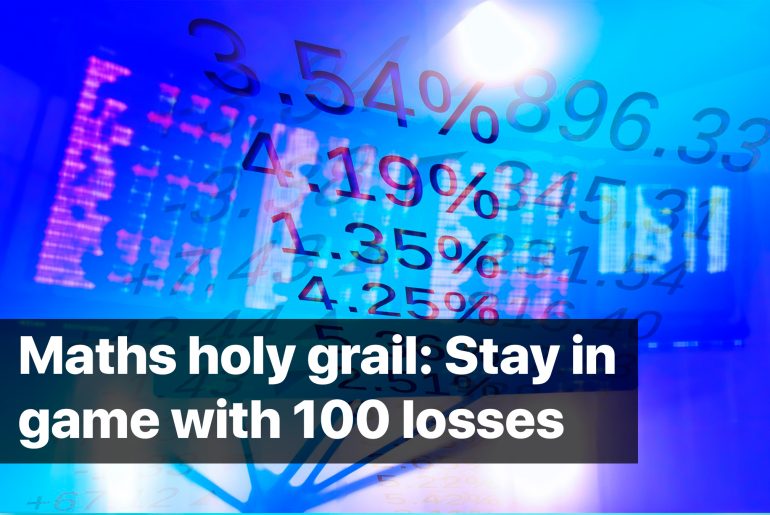In our previous articles, we discussed the key reason why 95% of traders lose and shared 4 secrets which can make you that 5% who take the market over and win millions! The core secret is risk management. Still are not sure that it is a holy grail? We are here to prove it and show that simple math works wonders. Let’s review a live example.
From this article, you’ll get a clear understanding that risk management protects your funds with powerful math! Thus, even if you have a streak of bad luck and fail 100 times in a row, you have a chance to stay in the game and multiply your deposit. Sounds like magic? Indeed, it does. But it’s real! Read how to become immortal in trading! And the first thing to start with, is a well-known quote:
“Know the enemy and know yourself; in a hundred battles you will never be in peril.”
© Sun Tzu
A quote from a Chinese military strategist Sun Tzu perfectly describes the best trading practices that help take trading to the next level. “Hundred battles” are your trades. So, how to survive even if they all are losing? Let’s start from the first part of the quote. Here we go!
“Know the enemy”
In trading, your enemy is, obviously, the losses: losses in a single trade, daily, monthly, yearly. All they are continuously cutting your profits. At the same time, it’s essential to remember an old unspoken rule: Losses are an integral part of trading, be you a newbie or a professional trader. While you win, somebody suffers losses – then you switch sides. And bots are not an exception.
However, some traders finally win, while others still lose. Why does this happen? Logically, beсause some traders manage their losses well and do not let them exceed returns. Thus, we all understand that to manage anything efficiently, it’s necessary to be totally aware of it. It is why successful traders pay incredible attention to losses: they record and calculate them carefully, continuously monitor and analyze to make smarter trading decisions and cut the losses. This is what risk management is about.
Risk management is based on powerful math laws that are able to take the market over!
It is a key part of the trading plan that sharpens the strategy, describing your actions in detail before, during and after each trade. In this case, you have a comprehensive picture of your actions, potential gains and losses. You calculate the uncertainties and predict their impact on final trading results. Isn’t it a real wonder?
Hence, in contrast to those who neglect risk management rules, ‘boring’ traders that calculate and record any step in trading are more likely to reach their trading goals. Why? Because they know their enemy in detail and already have a plan on how to deal with it. Everything is programmed! Let us review a simplified example of how it works.
Case study. Trading with risk management vs Trading without risk management
Imagine you have a deposit of 100 BTC and a choice to comply with risk management or not. There are plenty of risk management rules that ensure complex protection, but let us focus on a basic one to make an example as simple as possible to understand an overall mechanism.
Case №1. Trading without risk management
In the case №1, chose an easy way and had no worries about risk management. You set a simple rule to close the position if you lose 10 BTC in one trade, and control it with the help of stop-loss. Yes, you’re rich enough, but let’s see what happens if you do not manage your capital well.
No risk management applied
Thus, you need to lose 10 times in a row to lose a deposit. How swift can it happen? Even in a matter of a single day people lose millions! Specifically in terms of high market volatility (when the price changes abruptly). For example, on March 13, Bitcoin lost half of its value in a two-day plunge, making even experienced traders lose considerable sums and quit the market.

After you quit the market, you won’t be able to recover your deposit, therefore, you are out of the game, as 95% of traders. What do the rest 5% do? Review the next case.
Case №2. Trading with risk management applied
On the flip side, case №2 illustrates the usage of a single risk management rule. You decide that you close a trade since you lose 10% from your deposit. Sounds almost the same as the previous case, but there is a huge difference. You recalculate risk each time you lose to make it fit your current capital, decreasing in the same proportion. In contrast to the previous case, you lose 10 BTC, then 9 BTC, 8.1 BTC and so on. This simple trick makes your trading deposit almost immortal!
Risk management applied
Have a look at the yield curve. Even though you lose, you are still in-game with the losses getting smaller that does not let your deposit vanish. Thus, after losing 10 times you still have 34,87 BTC that is pretty enough to survive, recover your deposit and earn more.
Thus, since you are still in-game, you have the power to multiply what you have, even if you have a significant drawdown. Lazer your focus and act!
Note that this is a general simplified example to illustrate the major working principles of risk management. The real-life risk management strategies are rather complex.
To sum it up, with the right risk limit set (generally, it is 1%-2% per trade), you ensure your survival in the case of even a disaster and are able to succeed in trading! To clarify, if you set a 1% risk limit for 1 trade, in the case of 10 losses in a row (having 10 stop losses worked), you’ll lose only 10% from your deposit. So, do you have 100 losses in a row? No problem, you are still in the market! You may argue that 100 is significantly more than 10. Yes, you’re right, but smart math is more powerful than you may consider.
First of all, 100 losses in a row have an extremely low statistical probability. Why? Simply, because in a single trade you either win, or lose (roughly saying, the probability to lose is 1/2)*. Thus, to suffer 100 losses you need to have the events of probability ½ happen 100 times in a row, which results in 1/2^100. Your calculator will be shocked and will tell you that it’s 7.8886091e-31. In simple words, it’s a tiny probability.
*Please note that for each strategy it’s important to rely on your own statistics and key performance indicators, for example, win-loss ratio to estimate probabilities adequately.
Secondly, even with such a low probability, you are still in the market and are able to recover losses and earn more! Below you can see the simple calculations:
- Deposit: 100 BTC
- Risk-limit per trade: 1%
- The number of losses: 100 in a row (what a disaster!)
As a result, you still have 39,26 BTC that is one of the best options in the case of losing 100 times in a row.
Thus, with the basic knowledge of risk management, you are likely to succeed in case of several losses in a row. Imagine then how profitable your trading could be in case of a streak of good luck!
In contrast, obviously, without risk management, you are likely to fail and quit the market even after the 10th loss in a row. The choice is yours!
As you can see, math has unlimited power over losses. What you need is simply to use in your favor. By the way, if you already know your win-loss ratio, you can calculate an optimal share of possible losses that you can afford in each trade to stay in the market forever! Do it manually, or find the tools and necessary indices to control your losses with the help of math in Bitinsure.
At the same time, note that while developing a risk management system, not only math and logic matters. It also includes self-awareness and a lion share of psychology. Thus, it’s important to understand your peculiarities and ambitions. In our next article, we discuss how self-awareness can boost trading results. Welcome!
Stay tuned and join our social media:
Telegram: https://t.me/bitinsurecom
Facebook: https://www.facebook.com/bitinsure
Twitter: https://twitter.com/bitinsure_news





